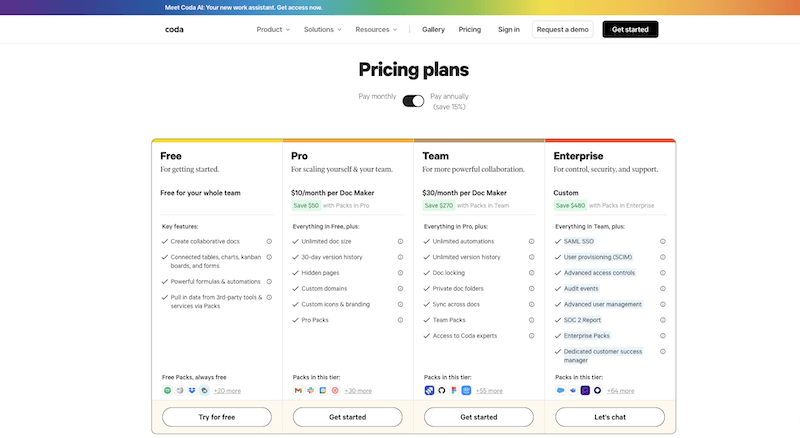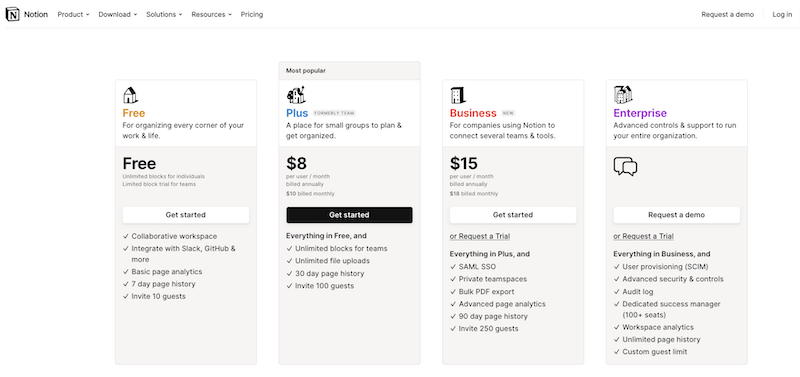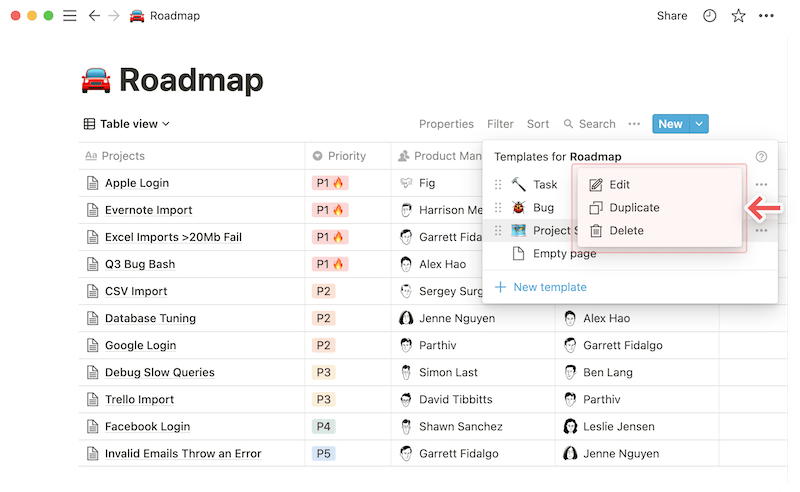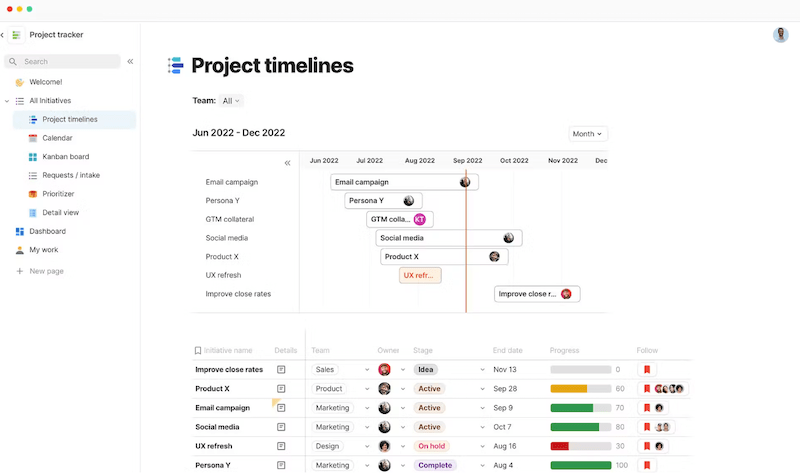
In project management, efficiency, collaboration, and organization are paramount – choosing the right tool can make all the difference. Both Coda and Notion have gained significant traction among professionals across various industries. We evaluated each tool’s strengths, weaknesses, and unique selling points to provide a comprehensive analysis to help individuals and teams select the best product for their use cases.
Jump to:
Coda is a web-based platform that combines the functionality of documents, spreadsheets, and databases. It allows users to create interactive documents that can be used for various purposes, including project management, task tracking, team collaboration, and data analysis.
Coda provides a flexible and customizable environment where users can create tables, charts, forms, and other interactive elements within their documents. It supports formulas and functions like traditional spreadsheets, allowing users to perform calculations and automate processes.
Notion is an all-in-one workspace, productivity, and collaboration tool that allows users to create and organize various types of digital content. It combines note-taking, project management, document collaboration, and database functionalities into a single platform.
Notion is one of the best project management tools for startups and freelancers – it provides a flexible and customizable interface where users can create pages, documents, and databases using a block-based system. These blocks can contain different types of content, such as text, images, files, to-do lists, tables, calendars, and more. Users can organize these blocks hierarchically to fit their specific needs and workflows.
| Features | Coda | Notion |
|---|---|---|
| Best for | Large teams, features | Small teams |
| Starting price (billed annually) | $10 per month per doc maker | $8 per user per month |
| Free plan | Yes, up to 50 objects and 1000 rows | Yes |
| Kanban boards | Yes | Yes |
| Gantt charts | Yes | No |
| Page history | Yes | Yes |
| AI assistant | Yes | Yes |
| Team hubs and wikis | Yes | Yes |
| Community | Good | Excellent |
| Learning curve | Moderate difficulty | Requires time to learn |
| Views | Kanban, word cloud, table, card, detail, calendar, Gantt, timeline, form | Kanban, calendar, list, table, timeline, gallery |
| Platforms | Web, iOS, Android | Web, iOS, Android, Mac, Windows |
Both Coda and Notion offer a free plan and three paid plans. The amount you will pay depends on the features you need.
Coda offers monthly and annual payment options.
Coda is available at no cost for an unlimited number of users. While the free plan may appeal to budget-conscious businesses, it may not be worth it due to its limited features. Before purchasing, those looking to test the tool may sign up for the free plan to explore the features. The free plan offers enough features to understand how Coda can help them simplify processes and collaborate with others.
Key features of Coda free plan
Coda Pro plan is designed for start-ups and fast-growing businesses. It costs $10 per month per doc maker when billed annually or $12 per month per doc maker when billed monthly.
Key features of Coda Pro plan
Those looking to collaborate on Coda may find the Team plan beneficial. It costs $30 per month per doc maker or $36 per month per doc maker.
Key features of Coda team plan
Coda doesn’t advertise its enterprise plan pricing on its website. They encourage interested buyers to contact their sales team for custom quotes.
Key features of Coda enterprise plan
Read our comprehensive Coda review to determine if it’s the best option for you.
Notion pricing plan breakdown is as follows.

With Notion’s free plan, individuals can invite up to 10 guests and create unlimited blocks. This plan best suits those seeking free collaborative software to manage projects, tasks, and knowledge-base.
Key features of Notion free plan
Notion’s Plus plan costs $8 per user per month when billed annually or $10 per user per month when billed monthly. It offers unlimited blocks for teams and unlimited file uploads. Plus users get access to all regular core features, as well as priority support, custom notion.site domain with a public home page and unlimited synced databases.
Key features of Plus plan
Companies using Notion to connect several teams and tools will find Notion’s business plan beneficial. The plan costs $15 per user per month when billed annually or $18 per user per month when billed monthly.
Key features of Business plan
Notion doesn’t advertise its enterprise plan pricing on its page. Interested buyers can contact the company for custom quotes. Notion’s enterprise plan core features are as follows:
Read our comprehensive Notion review to determine if it’s the best option for you.
At first glance, Notion seems like the most affordable option, while Coda appears expensive when you compare their pricing. This may be the case for small businesses or teams with few members. However, Coda may be the most affordable option if you have a large team. For clarity, Notion charge per user; if you have ten people on your Plus plan, you have to pay $10 per user per month – making $100 per month. On the other hand, Coda only bill you based on the number of doc makers or creators on your team, meaning if you have a team of 10 on the Pro plan and only two members have the right to create documents, you will only pay $24 per month.
When it comes to cost, there is a thin line between which project management tool has the most affordable rate. The cheapest option for you depends on the number of users in your team. If you are a small team, it is the most affordable option, while Coda is cheaper for fast-growing or large teams.
Here is how Coda and Notion compare in terms of their database capabilities.
In Coda, databases are based on tables, similar to spreadsheets. You can define columns, format data, and create formulas within cells. On the other hand, Notion uses a block-based structure, where each block can represent a different type of data, such as text, checkboxes, dates, etc. It allows you to create linked databases by using relational properties.

Coda provides a wide range of views allowing you to visualize and interact with your data differently. It has nine views: tables, cards, detail, calendar, timeline, chart, forms, word clouds, and boards.
Notion also offers various database views for you to choose base on your needs. They include a table, board, list, timeline, gallery, and calendar views. These views give you flexibility in how you display and organize your data.
Both Coda and Notion support formulas and functions to perform calculations and manipulate data within their respective databases. However, Coda has a more extensive formula language and provides advanced features like cross-table calculations (cross-doc actions). It is also easier to write formulas in Coda than in Notion.
Notion focuses on simplicity and minimalism in its design. Its interface is clean and uncluttered, making it easy to navigate and understand. Notion organizes content hierarchically using pages, subpages, and databases. The drag-and-drop functionality allows users to rearrange and organize their content effortlessly. The learning curve for Notion is generally considered to be relatively low, and many users find it intuitive to use.

On the other hand, Coda aims to provide a more flexible and customizable experience. It combines the functionalities of spreadsheets, documents, and databases into a single tool. While this versatility offers a lot of power and potential, it can also make Coda slightly more complex to use initially. Creating custom tables and formulas may require a bit of learning, especially for users who are not familiar with spreadsheets.
Notion sweeps the victory over Coda when it comes to user experience.
The best option for you depends on your organization’s needs, preferences, and use case.
If this tool doesn’t meet your needs, we also reviewed the best project management software for various types of user and use cases.
For this review, we gathered primary data from the vendor’s websites and tested the tool to gain first-hand experience. To identify each tool’s strengths and weaknesses, we reviewed customer feedback and ratings from review websites to learn about current and past user experiences.